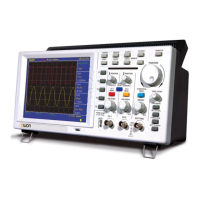User’s Manual of OWON Colour Digital Storage Oscilloscope
32
4. Press F2 selection button to switch over source channel CH1 and CH2.
5. Press F3 button to select WINDOW, including Rectangle、Hamming、Hanning and
Blackman.
6. Press F4 to choose the Format as dB or Vrms.
7. Press F5 to zoom in or out the wave of the multiple including *1, *2, *5, *10.
8. Adjust the “Horizontal” knob in horizontal control zone to move the waveform and
the shown frequency of M Pos is the exact frequency of the cursor point in the middle
of spectrum.
9. Press F1 to choose off to Turn off FFT and then press math menu button to go back
to the second page of wave math.
Selecting an FFT Window
■ The FFT feature provides four windows. Each one is a trade-off between frequency
resolution and magnitude accuracy. What you want to measure and your source signal
characteristics help determine which window to use. Use the following guidelines to select
the best window.
Type Description Window
Rectangle
This is the best type of window for resolving
frequencies that are very close to the same value
but worst for accurately measuring the amplitude of
those frequencies. It is the best type for measuring
the frequency spectrum of nonrepetitive signals and
measuring frequency components near DC.
Use rectangle for measuring transients or bursts
where the signal level before and after the event are
nearly equal. Also, use this window for
equal-amplitude sine waves with frequencies that
are very close and for broadband random noise with
a relatively slow varying spectrum.
Hamming
This is a very good window for resolving
frequencies that are very close to the same value
with somewhat improved amplitude accuracy over
the rectangle window. It has a slightly better
frequency resolution than the Hanning.
Use Hamming for measuring sine, periodic, and
narrow band random noise. This window works on
transients or bursts where the signal levels before
and after the event are significantly different.

